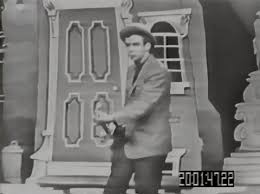
The second national broadcast of American Bandstand aired on Tuesday, August 6, 1957. While the historic debut the day before had set the tone, this episode marked the moment when the show began to settle into its daily rhythm. The excitement was still fresh, but now there was a growing sense of familiarity—of teenagers across America returning to the screen with a feeling that this might just become part of their daily lives.
The Studio Comes to Life Again
Just 24 hours after the coast-to-coast debut, the studio at WFIL-TV was once again filled with local teens, carefully chosen for their style, energy, and, of course, their dancing. The linoleum floors had barely cooled down before the next wave of saddle shoes and bobby socks took to the floor.
Dick Clark, as composed as ever, opened the show with a warm welcome. He knew this was the crucial moment—not just to retain the new national audience, but to prove that the magic of the first episode wasn’t a fluke. With his familiar poise, he reintroduced the Bandstand formula: music, movement, and the marvelous unpredictability of live youth culture.

Musical Guests: New Names, Big Sounds
The episode featured two musical guests who, while not household names like Elvis, brought distinctive voices to the stage.
Dale Hawkins: Known for his rockabilly edge, Dale took the mic to perform “Susie Q.” Though still a relatively new name at the time, his performance had a raw energy that stood out. His voice had a gravelly Southern charm, and his guitar-driven sound gave the show a burst of grit amidst the polished pop.
Don Rondo: In contrast, Don Rondo delivered a smooth, crooning rendition of his hit “White Silver Sands.” With his polished look and velvet baritone, he appealed to a slightly older segment of the teenage crowd—those who leaned toward traditional pop rather than rock and roll.
The pairing of Hawkins and Rondo on the same bill reflected one of Bandstand’s great strengths: its ability to showcase the full spectrum of mid-century youth music.

On the Dance Floor: A Growing Cast of Familiar Faces
With only one episode behind them, viewers had already begun to pick out their favorite dancers. Familiar couples returned to the floor, alongside a few new pairings that would eventually gain their own followings.
Arlene Sullivan and Kenny Rossi: Their confidence was even more noticeable than the day before. Today they danced with more intention, aware now that eyes from across the country were watching. Their movements were crisp, their rhythm tight. Arlene’s smile beamed brighter under the lights.
Justine Carrelli and Bob Clayton: Back for a second day, Justine wore a lighter dress that fluttered just so with every turn. Bob’s calm demeanor gave their dances an understated grace, especially during slower numbers like Rondo’s performance.
Carole Scaldeferri and Frank Brancaccio: A lively pair from South Philadelphia, they brought the energy. Their fast footwork during “Susie Q” caught the camera’s attention more than once, and you could tell they were becoming fast favorites.
There were also newer dancers stepping into the spotlight—young teens who had waited in line outside the studio or were chosen from local high schools. Some were shy, some bold, but all were aware: this was no longer a local dance show. This was America’s dance floor.
Fashion and First Impressions
Part of the appeal of American Bandstand—especially for teenage viewers—was the chance to spot fashion trends. The second episode gave viewers more looks to admire: pastel cardigans, saddle shoes, pleated skirts, boys with pressed shirts and narrow ties. Everything was neat, deliberate, yet still youthful.
For teens watching at home, it wasn’t just about the music. It was about seeing someone like them—maybe with better rhythm—on television. And maybe copying a hairstyle or dress choice the next day at school.
Viewer Reactions and the Start of a Ritual
The mailbags began to fill more quickly after this episode. Girls asked who the boy with the dark tie was. Boys wanted to know the name of the girl in the checkered skirt. Parents wrote in too—many relieved by the show’s wholesomeness, others surprised by how captivated they were themselves.
It was becoming a ritual. At 3:00 PM, the country was starting to gather. Living rooms in Chicago, Baltimore, and Tulsa all shared the same soundtrack. Kids weren’t just listening anymore. They were watching, imitating, dreaming.
A Quiet Triumph
While the debut had the weight of “firsts” behind it, August 6 was arguably even more important. It proved the show had staying power. That this wasn’t just lightning in a bottle. It was going to be every day, and it was going to matter.
The camera didn’t blink. The music didn’t stop. And somewhere, in some living room far from Philadelphia, a teenager watching that second episode felt a little more connected to the world.
Do you remember the first time you watched American Bandstand in its early days? Or do you recall a favorite dancer or song from that week? We’d love to hear your story.
Share your memory with us: